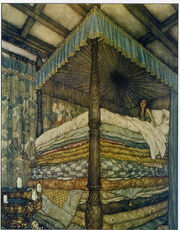
1911 Illustration by Edmund Dulac
"The Princess and the Pea" (Danish: "Prinsessen paa Ærten"; literal translation: 'The Princess on the Pea') is a literary fairy tale by Hans Christian Andersen about a young woman whose royal identity is established by a test of her physical sensitivity. The tale was first published with three others by Andersen in an inexpensive booklet on 8 May 1835 in Copenhagen by C.A. Reitzel.
Andersen had heard the story as a child, and it likely has its source in folk material, possibly originating from Sweden as it is unknown in the Danish oral tradition. Neither "The Princess and the Pea" nor Andersen's other tales of 1835 were well received by Danish critics, who disliked their casual, chatty style, and their lack of morals.
Plot[]
The story tells of a prince who wants to marry a princess, but is having difficulty finding a suitable wife. Something is always wrong with those he meets, and he cannot be certain they are real princesses because they have bad table manners or they are too fat or thin or not beautiful. One stormy night a young woman drenched with rain seeks shelter in the prince's castle. She claims to be a princess, so the prince's mother decides to test their unexpected, unwitting guest by placing a pea in the bed she is offered for the night, covered by 20 mattresses and 20 feather-beds. In the morning, the guest tells her hosts that she endured a sleepless night, kept awake by something hard in the bed that she is certain has bruised her. The prince rejoices. Only a real princess would have the sensitivity to feel a pea through such a quantity of bedding, so the two are married.
Sources[]
In his preface to the second volume of Tales and Stories (1863) Andersen claims to have heard the story in his childhood, but the tale has never been a traditional one in Denmark. He may as a child have heard a Swedish version, "Princess Who Lay on Seven Peas" ("Princessa' som lå' på sju ärter"), which tells of an orphan girl who establishes her identity after a sympathetic helper (a cat or a dog) informs her that an object (a bean, a pea, or a straw) had been placed under her mattress.
Publication[]
"The Princess and the Pea" was first published in Copenhagen, Denmark by C.A. Reitzel on 8 May 1835 in an unbound 61-page booklet called Tales, Told for Children. First Collection. First Booklet. 1835. (Eventyr, fortalte for Børn. Første Samling. Første Hefte. 1835.). "The Princess and the Pea" was the third tale in the collection, with "The Tinderbox" ("Fyrtøiet"), "Little Claus and Big Claus" ("Lille Claus og store Claus"), and "Little Ida's Flowers" ("Den lille Idas Blomster"). The booklet was priced at twenty-four shillings (the equivalent of 25 Dkr. or approximately US$5 as of 2009), and the publisher paid Andersen 30 rixdollars (US$450 as of 2009). A second edition was published in 1842, and a third in 1845. "The Princess and the Pea" was reprinted on 18 December 1849 in Tales. 1850. with illustrations by Vilhelm Pedersen. The story was published again on 15 December 1862, in Tales and Stories. First Volume. 1862.
The first Danish reviews of Andersen's 1835 tales appeared in 1836, and were hostile. Critics disliked the informal, chatty style, and the lack of morals, and offered Andersen no encouragement. One literary journal failed to mention the tales at all, while another advised Andersen not to waste his time writing "wonder stories". He was told he "lacked the usual form of that kind of poetry ... and would not study models". Andersen felt he was working against their preconceived notions of what a fairy tale should be and returned to writing novels, believing it to be his true calling.
See also[]
- List of fairy tales by Hans Christian Andersen